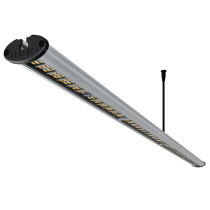All plants require ultraviolet light (UV) in order for photosynthesis to occur. A drawback to LED grow lights have been that they don’t produce the UV spectrum as readily as other styles, but that’s where UV spectrum LED grow lights come in.
What is UV?
Ultraviolet light is a type of electromagnetic radiation that usually comes from natural sunlight. UV light is present into three different sections of different wavelengths: UVA: 400nm-315nm UVB: 315nm-280nm UVC: = 280nm-100nm.
Although UVC does not naturally exist on earth due to our atmosphere, UVB and UVA are both important parts of human life. In the past, only outdoor grown plants benefited from UV exposure, but now we can now give plants the benefits of UV light when grown indoors. Some indoor grow lights have UV built in, but you can also supplement UV with LED UV bars or MH lamps.
Do standard grow lights emit UV?
Most standard grow lights, unless otherwise stated, only emit lights within the red-blue spectrum, omitting the infrared and UV spectrums, which can be detrimental to plants. Supplementing with an LED UV-b grow light will not only increase photosynthesis, giving the plant more energy to grow, but it will increase overall potency and trichome production. Remember, UV light can be harmful in too high of doses, so use this type of light sparingly and under the correct conditions.
What light spectrum is best for plants?
The good news is that plants do not need much UV light for photosynthesis to occur. However, specific species do prefer certain color wavelengths for optimal performance. Vegetable LED grow lights produce more of the blue spectrum, while LED lights designed for blooming plants produce more of the red spectrum. Plants need both spectrums for the two different phases of their life, so consider going with a Full spectrum LED grow lights to cut out the hassle of changing lights!
What are the benefits for growing with UV?
- Increases root mass
- Causes more branching, less stretching
- Improves taste and smell
- Creates more potent plants
- Increases resistance to insects, bacteria and fungus
- Increases oils & resins
- Reduced plant shock when transferred ourdoors
- Speed up the germination process for starting seeds when grown indoors
If you want to learn more about the different types of grow lights and how they each affect your plants differently, check out our learning center!




















